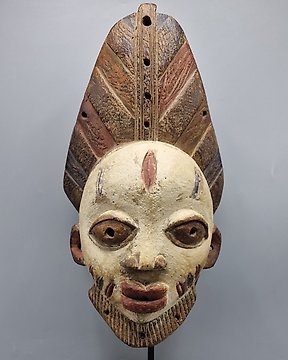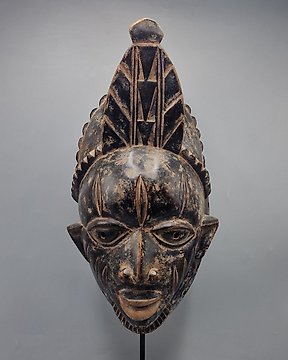Ibeji-dukken - Joruba - Nigeria (Ingen reservasjonspris)
Nr. 84044797

Ibeji - Joruba - Nigeria (Ingen reservasjonspris)
Nr. 84044797

Ibeji - Joruba - Nigeria (Ingen reservasjonspris)
Ibeji twin figures, from the Yoruba people, both stand on a wooden base, long flat feet, small legs, thin abdomen, arms and hands fall down to the hips, the oval head is mounted with a conical shaped hairdo with remnants of washing blue, the face features have been worn out and erased yet can still be noticed, both sculptures have a multiplicity of colored necklaces around their neck, arms and their waist, the female sculpture has some around her ankles, the both have shell earrings. The blue bracelets are to honor Orisha Eshun who is the mother of many children.
Sources: Doppel-Leben Ibeji Zwillingsfiguren, Hanni Jantzen und Ludwig Bertsch SJ. Munchen: Hirmer 1993, p.80.
Enzyklopadie Der Ibeji, Fausto Polo, p.496.
“Yoruba peoples have one of the highest incidents of twin births in the world. As a result, twins are regarded as extraordinary beings protected by Sango, the deity of thunder. They are believed to be capable of bestowing immense wealth upon their families or misfortune to those who do not honor them. Powerful spirits in life, twins are honored with carved memorial figures when they die. These figures, known as ere ibeji (literally meaning ere: sacred image; ibi: born; eji: two), remain a point of access to the spirit of the departed individual. The mother provides ritual care to the figures, bathing, dressing, adorning, and feeding them. Such daily handling is responsible for giving their surface its distinctive patina. Ere ibeji invariably represent their subjects with mature adult physiognomies, and are often crowned with elaborate hairdos.”
Lit: The Metropolitan Museum of Art.
Height: 29,5 cm / 29 cm
Weight: 280 g / 310 g
Du vil kanskje også like
- 16+
Dette objektet ble vist i
Hvordan kjøpe på Catawiki
1. Oppdag noe spesielt
2. Legg inn det høyeste budet
3. Å gjøre en sikker betaling







